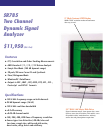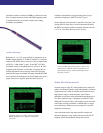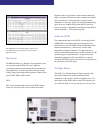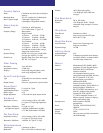
SR785 Specifications
Specifications apply after 30 minutes of warm-up and within two
hours of last auto-offset. All specifications are with 400 line FFT
resolution and anti-alias filters enabled unless stated otherwise.
Measurement Groups
Standard Groups FFT analysis, Correlation, Time
Histogram, Swept Sine
Optional Group Order Tracking
Frequency
Range 102.4 kHz or 100 kHz (both displays
have the same range).
FFT Spans 195.3 mHz to 102.4 kHz or 191 mHz to
100 kHz. The two displays can have
different spans and start frequencies.
FFT Resolution 100, 200, 400 or 800 lines
Real-Time Bandwidth 102.4 kHz (highest FFT span with con-
tinuous data acquisition and averaging).
Accuracy 25 ppm from 20 ˚C to 40 ˚C
Dynamic Range
Dynamic Range -90 dBfs typical, -80 dBfs guaranteed
(FFT and Octave)
-145 dBfs typical (Swept-Sine)
Includes spurs, harmonics, intermodu-
lation distortion and alias products.
Excludes alias responses at extremes of
span.
Harmonic Distortion <-80 dB (single tone in band)
Intermod. Distortion <-80 dB (two tones in band, each
less than -6.02 dBfs)
Spurious <-80 dBfs
Alias Responses <-80 dBfs (single tone outside of span,
less than 0 dBfs, less than 1 MHz)
Full Span FFT Noise 100 dBfs typical (input grounded, input
Floor range >-30 dBV, Hanning window,
64 RMS averages)
Residual DC Response <-30 dBfs (FFT with Auto Cal on)
Amplitude Accuracy
Single Channel ±0.2 dB (excluding window effects)
Cross Channel ±0.05 dB (dc to 102.4 kHz)
(frequency response measurement, both
inputs on the same input range, RMS
averaged)
Phase Accuracy
Single Channel ±3.0 deg relative to External TTL
trigger (-50 dBfs to 0 dBfs, freq
<10.24 kHz, center of frequency bin,
DC coupled). For Blackman-Harris,
Hanning, Flattop and Kaiser windows,
phase is relative to a cosine wave at the
center of the time record. For Uniform,
Force and Exponential windows, phase
is relative to a cosine wave at the
beginning of the time record.
Cross Channel ±0.5 deg (dc to 51.2 kHz)
±1.0 deg (dc to 102.4 kHz)
(frequency response measurement, both
inputs on the same input range, vector
averaged)
Signal Inputs
Number of Inputs 2
Full Scale Input Range -50 dBV (3.16 mVpk) to +34 dBV
(50 Vpk) in 2 dB steps
Maximum Input Level 57 Vpk
Input Configuration Single-ended (A) or true differential
(A-B)
Input Impedance 1 MΩ + 50 pF
Shield to Chassis Floating mode: 1 MΩ + 0.01 mF
Grounded mode: 50 Ω
Shields are always grounded in
differential input (A-B)
Maximum Shield Voltage 4 Vpk
AC Coupling -3 dB rolloff at 0.16 Hz
CMRR 90 dB at 1 kHz (in. range <0 dBV)
80 dB at 1 kHz (in. range <10 dBV)
50 dB at 1 kHz (in. range ≥10 dBV)
ICP Signal Conditioning Current Source: 4.8 mA
Open Circuit Voltage: +26 V
A-Weight Filter Type 0 Tolerance, ANSI Standard
S1.4-1983; 10 Hz to 25.6 kHz
Crosstalk <-145 dB below signal (input to input
and source to inputs, 50 Ω receiving
input source impedance)
Input Noise <10 nVrms/√Hz (<-160 dBVrms/√Hz)
above 200 Hz
Trigger Input
Modes Free run, Internal, External, or External
TTL
Internal Level adjustable to ±100% of input
scale, positive or negative slope.
Minimum Trigger Amplitude: 5% of
input range
External Level adjustable to ±5 V in 40 mV
steps, positive or negative slope.
Input impedance: 1 MΩ
Max input: ±5 V
Minimum trigger amplitude: 100 mV
External TTL Requires TTL level to trigger
(low <0.7 V, high >3.0 V)
Post-Trigger Measurement record is delayed up to
100,000 samples after the trigger.
Pre-Trigger Measurement record starts up to 8000
samples prior to the trigger.
Tachometer Input
Pulses Per Revolution 1 to 2048
RPM Accuracy ±50 ppm (typical)
Tach Level Range ±25 V, ±5V, TTL
Tach Level Resolution 20 mV @ ±25 V, 4 mV @ ±5 V
Max. Tach Input Level ±40 Vpk
Min. Tach Pulse Width 100 nSec
Max. Tach Pulse Rate 750 kHz (typical)
















